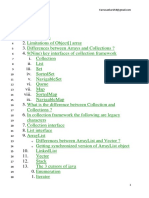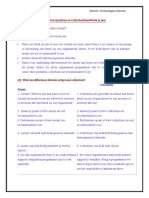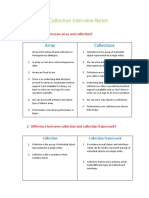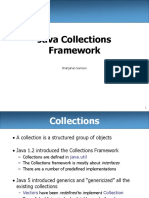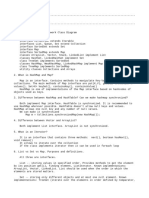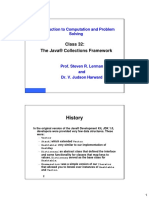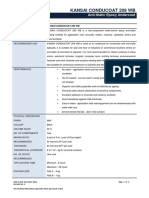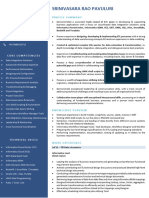Collections
1. What is the Collection framework?
Collection framework represents an architecture for storing and
manipulating a group of objects. Collection framework has interfaces,
classes and also few algorithms.
2. What is the root interface in Collection hierarchy?
Iterable interface is the root interface in collection hierarchy.
3. What is an Iterable interface?
Iterable interface facilitates to iterate the elements. It iterates in forward
direction only. It provides a generic way for traversal through the
elements of a Collections and implements Iterator design pattern.
4. Which design pattern is followed by Iterable interface?
Iterable interface follows iterator design pattern.
5. What was the java’s Collections framework equivalent in C++
called as?
Java’s Collections framework equivalent in C++ is called as Standard
Template Library.
6. What was the java’s Collections framework equivalent in smalltalk
called as?
Java’s collection framework equivalent in Smalltalk is called as Small
Talk Collection hierarchy.
7. What are the benefits of java’s Collection framework?
Advantages of Collections framework are as follows:
i) Reduces the effort in programming.
ii) Increases the speed of programming and quality.
iii) Allows inter-operability.
1
� iv) Reduces effort to design new software.
8. When was Collections framework introduced in java?
Collections framework was introduced into Java from JDK 1.2
onwards.
9. Which were the adhoc classes that were provided in java for
dealing with collection of objects before java’s Collection
framework was introduced?
Prior to Collections framework was introduced in Java, James Gosling
had provided four classes in order to perform storage and retrieval of
the objects namely,
i) Vector
ii) Stack
iii) HashTable and
iv) Properties
10. What was the problem with these adhoc classes?
Although these legacy classes were useful, they lacked a central
unifying theme. This created a lot of confusion for the programming
community because the way Vector class used was different from the
way Stack class or HashTable class was used. This adhocness lead to
the emergence of the Collections hierarchy.
11. What is a Dictionary?
Dictionary is a legacy abstract class. It contains <key-value> pair. It is
much like today’s Map class.
12. What is a Hashtable?
HashTable is a legacy class. HashTable is the concrete implementation
of Dictionary.
13. What is a Properties class?
Properties class is a legacy class. It is a subclass of HashTable class. It
1
� is used to maintain <key-value> pair such that both key and value are
String.
Eg. <”Dhoni”, “Mahi”>
14. When does a ClassCastException occur?
Whenever in a program we attempt to typecast incompatible types then
ClassCastException will occur.
15. When does an UnsupportedOperationException occur?
Whenever we attempt to modify an un modifiable Collection, then
UnsupportedOperationException will occur.
16. Name the three static variables present in Collection
framework?
1) EMPTY_SET
2) EMPTY_LIST
3) EMPTY_MAP
17.Differentiate between Array and ArrayList?
Arrays ArrayList
Can store only primitive data. Can store only Objects
Arrays are fixed in size. They ArrayList can grow or shrink in size
cannot grow or shrink during during program execution
program execution.
Can store only homogeneous data. Can store heterogeneous data.
Creation takes less time Creation would take more time
because auto boxing has to take
place using wrapper classes
Auto boxing is not required. Auto boxing is required.
1
� 18. When will we use Array over ArrayList?
1) When the size of the array is either fixed or known earlier.
2) When we have only primitive data have to be stored.
3) When we have multi-dimensional data have to be stored.
19. What are the similarities between ArrayList and Vector?
1) ArrayList and Vector maintains the order of insertion.
2) ArrayList and Vector are both fail-fast.
3) ArrayList and Vector allow null values, both provide index based
accessing.
20. Differentiate between ArrayList and Vector?
ArrayList and Vector are almost similar. However, Vector class is
synchronized whereas ArrayList if not synchronized.
21.Differentiate between ArrayList and LinkedList?
ArrayList LinkedList
Internally makes use of dynamic array Internally makes uses of linked list
Suitable for performing rear end Suitable for performing insertion at all
insertion given position
Cannot utilize dispersed memory Can utilize dispersed memory location
location
22.Differentiate between Iterator and ListIterator?
Iterator ListIterator
Can be used to access objects Can be used to access objects
present in all the seven Collections present in only list based classes
classes
1
� Iterator can iterate upon Collections ListIterator can iterate upon
only in the forward direction Collections both in forward and
reverse direction
23.Differentiate between Iterator and Enumeration?
Iterator Enumeration
Iterator can traverse legacy and non- Enumeration can traverse only
legacy elements legacy elements
Iterator is fail-fast Enumeration is not fail-safe
Iterator is slower than Enumeration Enumeration is faster than Iterator
24.Differentiate between List and Set?
In List index based access is provided and also duplicates are allowed.
Where as in set, index based access is not permitted and duplicates are
not allowed.
25.Differentiate between HashSet and TreeSet?
HashSet TreeSet
Internally makes use of Hashing Internally makes use of balanced
algorithm binary search tree using red-black
algorithm
Objects would not get displayed in It would display the objects in
the sorted order sorted order because it would make
use of
in-order traversal.
Search time complexity is O(1) Search time complexity is O(log2n)
1
� 26.Differentiate between Set and Map?
Set Map
Set stores only values. Map stores <key, value> pair.
Set is a member of Collections Map is not a member of Collection
hierarchy. hierarchy.
As the complexity of an object Efficiency would not be reduced
increases, efficiency reduces. even though complexity increases
because hashing would be applied
on “key” and not on value.
27.Differentiate between HashSet and HashMap?
HashSet HaspMap
It is an implementation of Set It is an implementation of Map
interface Interface
Contains only values (objects) Contains object as <key,value> pair
Duplicates are not permitted Duplicate keys are not permitted.
However, duplicate values are
permitted
add() method would be used to put() method would be used for
insert an object insertion operation
One parameter has to be passed Two parameters have to be passed
while inserting an object. for put() method.
Eg. add(Object arg0); Eg. put(Object arg0, Object arg1)
put(key , value)
Slow in operation Fast in operation
1
� 28.Differentiate between HashMap and TreeMap?
HashMap TreeMap
Internally makes use of hashing Internally makes use of balanced
algorithm. binary search tree using red-black
algorithm.
Data cannot be retrieved in a sorted Data can be retrieved in a sorted
manner. manner.
29. Differentiate between HashMap and Hashtable?
HashMap HashTable
It is not a synchronized class. It is a synchronized class.
It is not a legacy class. It is a legacy class.
It can contain an empty Key or It cannot contain an empty Key or
Value pair. value pair.
Suitable for multithreaded Not suitable for multithreaded
programming programming
30. Differentiate between Collection and Collections?
“Collection” is an interface whereas “Collections” is a class.
31. Differentiate between Comparable and Comparator?
Comparable Comparator
It expects implementation for It expects implementation for
compareTo() method compare() method
1
� The first object is referred to as The first object is not referred to as
“this” “this”
It is present in java.lang package It is present in java.util package
Target class has to be modified Target class need not be modified
It is useful in such scenarios where It is useful in all the scenarios
the target class is modifiable
32. Are the List, Set and Map elements automatically
synchronized in java’s Collection framework?
No. They are not automatically synchronized.
33. How do we synchronize List, Set and Map elements?
Using Collections.synchronizeCollection(Collection c)
34. What is the advantage of generic Collection?
Advantages of generic collections are:
i) It is type safe
ii) It is checked at compilation time
iii) It prevents ClassCastException
iv) It makes the code clean since we need not use casting.
35. What is collision in Hashtable and how is it handled?
While computing bucket number for storing an object in hash table, if
hash function allocates the same bucket for two different objects, then
collision occurs. Therefore, hash function maintains a load factor which
is 0.75 or 75% which means, if the hash table gets filled by the objects
about 75% of its capacity, then automatically the size of the hash table
would increase so that collision would be avoided.
1
� 36. What is load factor in hashing base Collection?
While computing bucket number for storing an object in hash table, if
hash function allocates the same bucket for two different objects, then
collision occurs. Therefore, hash function maintains a load factor which
is 0.75 or 75% which means, if the hash table gets filled by the objects
about 75% of its capacity, then automatically the size of the hash table
would increase so that collision would be avoided.
37. Why is Map not a part of Collection framework?
Map is not a part of Collections framework because map contains <key,
value> pair and does not fit into the Collections framework paradigm
which contains only values.
38. What is the difference between fail-fast and fail-safe?
Fail-fast Fail-safe
It would result in termination of the Does not terminate the program by
program by generating an generating an Exception if structural
Exception if structural modification modification is attempted
is attempted
No clone is used Clone is used
All the Collections based classes All the Collections based classes
present in java.util package exhibit present in java.util.concurrent
fail-fast behavior package exhibit fail-safe behavior
39. How do we avoid ConcurrentModificationException while
iterating Collection?
To avoid ConcurrentModificationException we can make use of the
classes present in java.util.concurrent package.
40. What are the different Collection views provided by Map
interface?
1
� The different Collection views are:
1) Keyset
2) EntrySet
3) values.
41. How do you decide between using HashMap and TreeMap?
In the project, if insertion, deletion and locating elements operations are
of utmost important, then HashMap must be used. However, if
traversing the keys in a sorted order is important then TreeMap must be
used.
42. Which Collection classes are Thread-safe?
The legacy classes such as Vector, Hashtable, Properties and Stack are
thread safe classes because they are synchronized.
However, from jdk 1.5 onwards, Collections based classes that are
present in java.util.concurrent package such as CopyOnWriteArrayList,
CopyOnWriteArraySet, ConcurrentHashMap etc. are also thread safe
classes.
43. What is a blocking Queue?
Blocking Queue is a queue in which retrieval is possible if and only if
the queue is non-empty and insertion is possible only when space is
available. It is used for implementing producer-consumer problem.
44. How can we sort a list of objects?
We can sort a list of objects by :
i) Using TreeSet class
ii) Using Collections.sort() method.
45. While passing a Collection as argument to a function how can
we make sure that a function will not be able to modify it?
By creating read only collection using:
Collections.unmodifiableCollection(Collection c)
1
� 46.What are the common algorithms implemented in Collections
class?
i) Sorting
ii) Shuffling
iii) Routine Data Manipulation
iv) Searching
v) Composition
vi) Finding Extreme Values etc.
47. What are the best practices related to java Collections
framework?
i) Choose the best type of Collection depending upon objects to be
stored.
ii) If the number of objects to be stored is known in advance then
preferably we
can use Collections classes that allow us to specify the initial
capacity.
iii) We can always use generics for type safety and to avoid
ClassCastException at
run time.
iv) We can also use Collections utility class methods since it enhances
code
re-usability, greater stability and maintainability.
48. Which are the classes that have implemented the List
interface?
ArrayList and LinkedList classes.
49. Which are the classes that have implemented the Set
interface?
HashSet and LinkedHashSet classes.
50. Which are the classes that have implemented the Queue
interface?
1
� ArrayDeque and PriorityQueue classes.
51. Which are the classes that have implemented the Map
interface?
HashMap, TreeMap and LinkedHashMap classes.
52. Which methods do we have to override in order to use an
object as a key in HashMap?
We have to override hashCode() and equals() methods.
53. What is the difference between Stack and Queue?
Stack Queue
Uses LIFO (Last-In-First-Out) or Uses FIFO (First-In-First-Out) or
FILO (First-In-Last-Out) to add and LILO (Last-In-Last-Out) to add and
access data. access data.
Insertion and deletion would happen Insertion and deletion would happen
only at one end at separate ends.
For insertion, rear end would be
used.
For deletion, front end would be
used.
Implementation is relatively easy as Implementation is a bit complex as
Stack has no variants. Queue is having variants such as
Circular Queue, Priority Queue,
Double ended Queue etc.
54. How do we reverse the List in Collection?
We can reverse the list in collection by using Collections.reverse()
method.
1
� 55. How do we convert an array of String into a List?
We can convert an array of String into a list by using
Collections.addAll() or Arrays.asList() method.
56. What is the difference between peek(), poll() and remove()
methods of Queue interface?
peek() and poll() would return null if the queue is empty whereas
remove() would throw NoSuchElementException.
57. What is the difference between HashMap and
ConcurrenthashMap?
ConcurrentHashMap is synchronized and does not allow null key and
null value, whereas HashMap is not synchronized and allows null key
and null value.
58. Arrange the following in the descending order of
performance- ConcurrentHashMap, Hashtable, HashMap,
Collections.SynchronizedMap.
HashMap, ConcurrenthashMap, Collections.SynchronizedMap,
Hashtable.
59. How does HashMap work?
(Refer class notes).
60. What is identity HashMap?
Identity HashMap implements Map interface by using reference
equality instead of object equality.
61. What is weakHashMap?
WeakHashMap is an implementation of Map interface with weak keys.
1
� 62. What is a Data Structure?
A data structure is a specialized format for organizing and storing the
data.
Eg. Array, Queue, LinkedList, Tree etc.
63. Can any of the Collection class store primitive data?
No. In all the Collections classes data would be stored in the object
format.
64. What happens when a primitive data is given to a Collection
class?
When primitive data is given to a collections class, it would be
automatically converted into an object format. This process is called as
auto boxing.
65. What is meant by boxing?
(Refer class notes).
66. What is meant by auto-boxing?
(Refer class notes).
67. What is meant by unboxing?
(Refer class notes).
68. What is meant by auto-unboxing?
(Refer class notes).
69. What is the initial capacity of a Vector?
Initial capacity of a vector is 10.
70. By what factor does the capacity increase in case of a Vector
if the existing capacity is filled?
If the existing capacity is filled then the capacity doubles in existing
1
� size.
71. What are the different ways of printing a Vector?
We can print a vector by using Enumeration.
72. What are the different ways of printing a ArrayList?
We can print ArrayList by using:
i) for loop
ii) enhanced for loop
iii) iterator and
iv) ListIterator.
73. What are the different ways of printing a LinkedList?
We can print LinkedList by using:
i) for loop
ii) enhanced for loop
iii) iterator
iv) ListIterator and
v) DescendingIterator
74. What are the different ways of printing a ArrayDeque?
We can print ArrayDeque by using:
i) enhanced for loop
ii) iterator and
iii) DescendingIterator
75. What are the different ways of printing a PriorityQueue?
We can print a PriorityQueue by using:
i) enhanced for loop and
ii) iterator.
1
� 76. What are the different ways of printing a Treeset?
We can print a TreeSet using:
i) enhanced for loop
ii) iterator and
iii) DescendingIterator.
77. What are the different ways of printing a HashSet?
We can print a HashSet using:
i) enhanced for loop and
ii) iterator.
78. What are the different ways of printing a LinkedHashSet?
We can print a HashSet using:
i) enhanced for loop and
ii) iterator.
79. What are the different ways of printing a Treemap?
We can print a TreeMap using:
1) enhanced for loop
2) iterator and
3) DescendingIterator.
80. What are the different ways of printing a LinkedMap?
We can print a LinkedssMap using
1) enhanced for loop and
2) iterator.
81. What are the different ways of printing a LinkedHashMap?
We can print a LinkedHashMap using:
1) enhanced for loop and
1
� 2) iterator
82. What is the role of clone()?
A clone() method is used to create a new Collections object. It is an
alternative method to new operator and factory method to create the
objects.
83. How can an Array be converted to a List?
We can convert an Array into a List by using Arrays.asList() method.
84. How can a List be converted to an Array?
We can convert a List into an Array by using toArray() method.
85. What is the difference between add() and set()?
add() method is used to insert a new object at the specified position. If
any other object already exists in that position, then it would be shifted
to the right so that empty location would be created to insert a new
object.
In case of set() method, if any other object exists in the specified
position, then shifting towards right would not takes place. Rather, new
object would be replaced with old object by deleting it.
86. What is the role of retainsAll()?
The retainAll() method retains all matching elements in the
current ArrayList that match all elements from the derived Collection
list argument. In other words, retainAll() method is equivalent to
intersection operation.
87. Which are the Collection class in which duplicates are
permitted?
Duplicates are permitted in ArrayList, LinkedList, ArayDeque and
PriorityQueue classes.
88. Which are the Collection class in which duplicates are not
permitted?
1
� Duplicates are not permitted in TreeSet, HashSet and LinkedHashSet
classes.
89. Which are the Collection class in which null are permitted?
Null is permitted in ArrayList, LinkedList, HashSet and LinkedHashSet
classes.
90. Which are the Collection class in which null is not permitted?
Null is not permitted in ArrayDeque, PriorityQueue and TreeSet.
91. What are the two ways in which a LinkedList can be accessed in the
reverse order?
i) Using ListIterator
ii) Using DescendingIterator
(Eg. Refer class notes)
92. What is the difference between add() and offer()?
add() method would throw IllegalStateException if the space is not
available to insert an object into a Collections.
offer() method would not throw any Exception if the space is not
available to insert an object into a Collections. Rather, it would return
false.
93. Which Data Structure is used internally by the Vector class?
Vector uses Dynamic array data structure.
94. Which Data Structure is used internally by the ArayList
class?
ArrayList uses Dynamic array data structure.
95. Which Data Structure is used internally by the LinkedList
class?
Doubly linked list data structure.
1
� 96. Which Data Structure is used internally by the ArrayDeque
class?
Double ended queue data structure.
97. Which Data Structure is used internally by the PriorityQueue
class?
PriorityQueue uses min-heap data structure.
98. Which Data Structure is used internally by the TreeSet class?
TreeSet uses balanced binary search tree data structure using red-black
algorithm.
99. Which Data Structure is used internally by the HashSet
class?
HashSet uses Hashing algorithm.
100. Which Data Structure is used internally by the
LinkedHashSet class?
LinkedHashSet uses Hashing algorithm.
101. Which Data Structure is used internally by the TreeMap
class?
min-heap data structure.
102. Which Data Structure is used internally by the HashMap
class?
Hashing algorithm.
103. Which Data Structure is used internally by the
LinkedHashMap class?
Hashing algorithm.
104. Under what circumstances should we use the Vector class?
(Refer class notes).
105. Under what circumstances should we use the ArrayList class?
(Refer class notes).
1
� 106. Under what circumstances should we use the LinkedList
class?
(Refer class notes).
107. Under what circumstances should we use the ArrayDeque
class?
(Refer class notes).
108. Under what circumstances should we use the PriorityDeque
class?
(Refer class notes).
109. Under what circumstances should we use the TreeSet class?
(Refer class notes).
110. Under what circumstances should we use the HashSet class?
(Refer class notes).
111. Under what circumstances should we use the LinkedHashSet
class?
(Refer class notes).
112. Under what circumstances should we use the TreeMap class?
(Refer class notes).
113. Under what circumstances should we use the HashMap class?
(Refer class notes).
114. Under what circumstances should we use the LinkedHashMap
class?
(Refer class notes).
115. What is the role of ceiling () and floor ()?
(Refer class notes).
1
� 116. What is the role of higher () and lower ()?
(Refer class notes).
117. What is the role of headset () and tailSet ()?
(Refer class notes).
118. Give the Collection interface hierarchy?
(Refer class notes).
119. Give the Map interface hierarchy?
(Refer class notes).
120. How can we perform reverse sorting on a Vector?
(Refer class notes).
121. How do you sort the data present in non-indexing data
structure?
(Refer class notes).
122. How do you sort a Map?
(Refer class notes).














